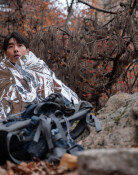Infinity of wildflowers blossoming in heaven
Infinity of wildflowers blossoming in heaven
Posted June. 26, 2023 07:54,
Updated June. 26, 2023 07:54

What would it be like to travel back in time? If you could go back and revoke your choice that led to failure and had visibility on how time would unfold, would you be able to make the optimal choice? However, unlike the digital world, we cannot turn time back to a specific point nor fast-forward to the future. We can only develop foresight on signs that hint at what may happen.
The first four rows of William Blake’s Auguries of Innocence are well-known. The ‘eye’ that can foresee the potential for heaven filled with wildflowers is the foreground. The visual verb ‘see’ hints at the beginning. The eye makes one think of Aleph, the first alphabet of Hebrew that means first. Borges created a kaleidoscope of wholeness through his book titled “Aleph.” He wrote that “each object was infinite,” referring to the world as a rainbow-colored kaleidoscope.
The sand and wildflowers described in Blake’s poems are infinite. It is a heaven of possibilities. The key is having the eye to spot this. The insight into wholeness is a passion for infinity. When we immerse ourselves in the moment, we are transported to an infinite moment that lasts forever. However, the sand and wildflowers set before me are mostly shabby. Many are uncertain and mysterious. Possibilities seem closed.
In these situations, it is crucial to keep our eyes wide open and use our hands. The eye is used to perceive, while the hands indicate action. I am myself based on the physical me that is visible. My hands help me lead to the world and help me experience myself in space. I dream of the infinity of wildflowers blossoming.







